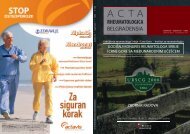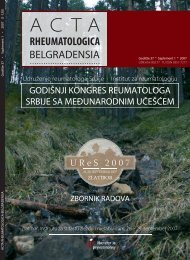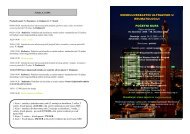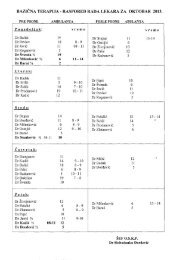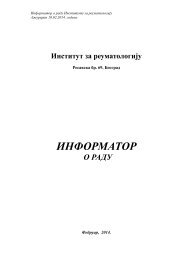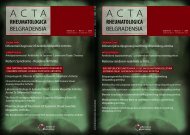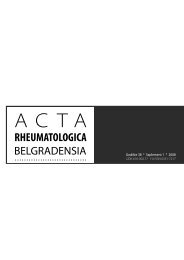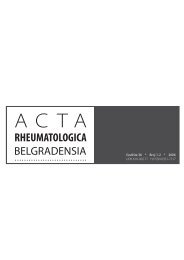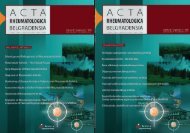Godište 35 supplement 2 - Institut za reumatologiju
Godište 35 supplement 2 - Institut za reumatologiju
Godište 35 supplement 2 - Institut za reumatologiju
Create successful ePaper yourself
Turn your PDF publications into a flip-book with our unique Google optimized e-Paper software.
SISTEMSKE BOLESTI VEZIVNOG TKIVA<br />
PREDAVANJE PO POZIVU (PP)<br />
PP 06.<br />
DO CLINICIANS KNOW ENOUGH ABOUT ANITIBODIES AGAINST BETA2-GLYCOPROTEIN I?<br />
Rozman B, Čučnik S, Božič B, Ambrožič A, Lukač J, Tomšič M, Kveder T<br />
Dept. of rheumatology, Medical Centre Ljubljana, Ljubljana, Slovenia<br />
Antibodies against beta2-glycoprotein I (anti-beta2-GPI) are beside anticardiolipin antibodies (aCL) among the most<br />
commonly detected subset of antiphospholipid antibodies (aPL). They are more speciffic for APS related manifestations than<br />
aCL. The inter-laboratory comparability of anti-beta2-GPI enzyme linked immunosorbent assay (anti-beta2-GPI ELISA)<br />
results is hardly possible due to methodological differences, lack of international standards and different cut-off values. We<br />
have already shown several methodological aspects influencing anti-beta2-GPI ELISA results (blocking agents, different<br />
plates). In 2000 we tested monoclonal antibodies HCAL (IgG) and EY2C9 (IgM), both kindly provided by T. Koike, as<br />
possible calibrators. Two years later we participated in a multicentre study on anti-beta2-GPI standardi<strong>za</strong>tion. Despite large<br />
variability of anti-beta2-GPI measurments among centers, the overall agreement on the results obtained for high- and mediumpositive<br />
samples was good. However, until today ELISA method for the detection of anti-beta2-GPI has stayed unstandardized,<br />
and anti-beta2-GPI not quantitatively evaluated. Anti-beta2-GPI have so far not been officialy included into the APS<br />
laboratory criteria.<br />
Moreover, there is an enormous heterogeneity among anti-beta2-GPI with substantial differences including epitopic specificity,<br />
avidity, light chain type or IgG subclass distribution and others. We previously reported of different epitopic specificities, and<br />
different in vitro behaviour using giant phospolipid vesicles. Additionaly, we studed the binding of anti-beta2-GPI to human<br />
and bovine beta2-GPI. We found typical binding patterns. In children with atopic dermatitis (AD) and without manifestation of<br />
APS the binding only to human beta2-GPI significantly decreased during the follow-up and the binding to bovine beta2-GPI<br />
did not change significantly. In contrast, significantly higher bindings to human beta2-GPI was observed predominantly in<br />
patients with APS duration over 10 years when compared to patients with shorter APS duration or patients with the presence of<br />
anti-beta2-GPI without any APS related manifestations. This phenomenon might reflect different autoimmune response –<br />
clonal selection in AD children with non-thrombogenic anti-beta2-GPI and autoantibody maturation in APS patients. Further,<br />
we focused on anti-beta2-GPI avidity. Low- , medium- and high-avidity antibodies were detected in patients with APS and<br />
SLE. High-avidity anti-beta2-GPI prevailed in APS patients and were associated with thrombosis, in particular with venous<br />
thrombosis. In individual patients we were not able to demonstrate any clear temporal relationship between high-avidity antibeta2-GPI<br />
and clinical manifestations of APS. Our participation in a multicentre study showed APS patients to produce<br />
antibodies against different peptides, very common on bacteria and viruses. The study opened an important issue of what role<br />
do infecting agents have in triggering APS. Most recently we studed the prevalence of anti-beta2-GPI in different infections<br />
including Lyme boreliosis, tick encephalomeningitis, hepatitis C, severe bacterial infections and hepatitis B vaccination. Antibeta2-GPI<br />
of different Ig classes ranged from 2,5% to 16,5%.



